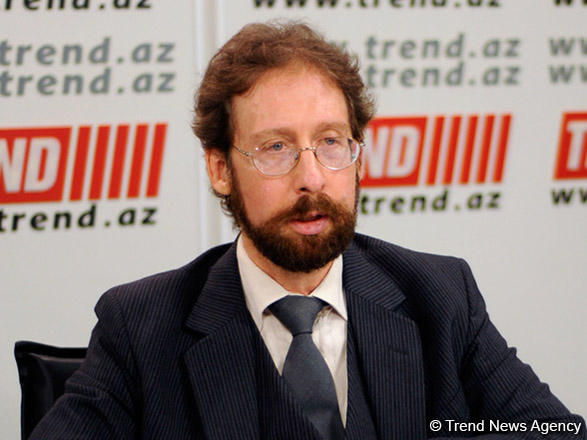BAKU, Azerbaijan, Oct.2
Trend:
Robert Cutler, a fellow at the Canadian Global Affairs Institute, assessed the development of the South Caucasus region in connection with the first anniversary of the start of the 2020 Second Karabakh War in his article published in New Europe media agency’s website, Trend reports.
According to the article, a trilateral working group [between Azerbaijan, Russia, and Armenia] to promote the region’s development was established at an inter-ministerial meeting on January 11, 2021 (in consequence of Point 9 of the November 10, 2020 ceasefire statement).
“Azerbaijan has been supplying Armenia (although it is not obligated to do so) with gas from Russia through its own national pipeline system,” Cutler wrote.
Another important aspect of the development is that the ceasefire statement calls for the opening of a corridor between Azerbaijan proper and its exclave the Nakhchivan Autonomous Republic, and there is indeed a railroad that can be rebuilt, the article read.
Armenia, however, according to the article, continues to insist instead on re-opening a longer and more circuitous railroad route [between Armenia and Azerbaijan] that doesn’t go through the Zangazur corridor.
“Not only would that route take a longer time for travel, but also it would cost more to reconstruct and refurbish,” Cutler added.
The article further said that the Turkish BOTAS energy company was interested in establishing a large physical plant on the border of Azerbaijan’s Nakhchivan Autonomous Republic and Armenia.
“If a pipeline could be constructed across southern Armenia for this purpose, it would have been possible to create jobs in southern Armenia, which needs economic development, through the construction of a processing complex to produce refined products for foreign export,” the Canadian researcher noted.
According to him, this pipeline [through the Zangazur corridor] would have been in Armenia’s longer-term interests, but Yerevan was handicapped by internal political deadlock [due to snap parliamentary election called] after the Second Karabakh War.
“Lacking a full cabinet, including a foreign minister (the ministry’s entire leadership had resigned earlier), in the wake of snap parliamentary election in Armenia called by its prime minister Nicol Pashinyan, the Yerevan government was unable to take any constructive decisions,” Cutler emphasized. “Faced with delays and indecisiveness on the part of the Armenian authorities, Azerbaijan and Turkey signed a Memorandum of Understanding for the Igdir-Nakhchivan pipeline’s construction to supply Nakhchivan from Turkey.”
As the article’s author said, the most immediate and effective confidence-building measure would be to facilitate the return of Azerbaijani civilians to the homes in the liberated territories from which they were driven by ethnic cleansing in the early 1990s. However, aside from the destruction of very many of those homes, the land mines sown by the Armenian forces before their departure from Azerbaijan’s Kalbajar, Lachin and Aghdam districts [under the trilateral statement between Azerbaijani, the Russian president, and Armenian prime minister of November 10, 2020] still threaten to return of the Azerbaijani civilians, the article further said.
The international community has begun to recognize the seriousness of the situation, and an increasing number of countries have stepped forward to supply funds, equipment, and training for the mine-clearing operations, the article noted.
Besides, according to the article, the OSCE Minsk Group is outdated and has no role to play.
“The slowness of multilateral international organizations relying upon consensus diplomacy cannot keep pace with the speed of developments today. What is absolutely certain is that the “Madrid Principles” are outdated. It is indicative that no one, not even from the Armenian side, has made serious reference to them since the end of the war [last November],” added Cutler.
Following over a month of military action to liberate its territories from Armenian occupation from late Sept. to early Nov. 2020, Azerbaijan has pushed Armenia to sign the surrender document. A joint statement on the matter was made by the Azerbaijani president, Armenia's PM, and the president of Russia.
A complete ceasefire and a cessation of all hostilities in the zone of the Karabakh conflict were introduced on Nov. 10, 2020.
The conflict between the two South Caucasus countries began in 1988 when Armenia made territorial claims against Azerbaijan. As a result of the ensuing war, the Armenian Armed Forces occupied 20 percent of Azerbaijan, including the Karabakh region and seven surrounding districts. The 1994 ceasefire agreement was followed by peace negotiations.






